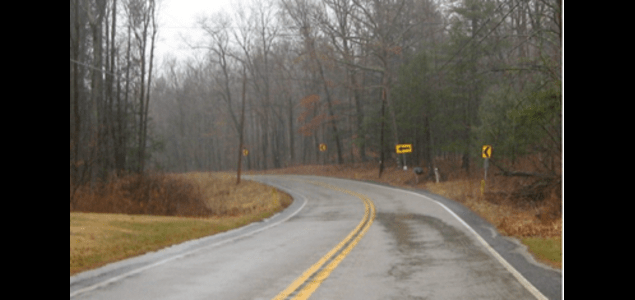
Pennsylvania sustains more traffic fatalities and serious injuries each year due to vehicles departing their travel lane compared to any other crash type, according to the Pennsylvania Crash Information Tool (PCIT).
Two-thirds of all fatal and serious injury lane departures include a collision with a fixed object, most commonly trees, utility poles, embankments, and guiderail.
More than half of all fatal and serious injury lane departures occur on rural roads. Given Pennsylvania's large rural network, this issue must be addressed through a systemic and spot-specific infrastructure improvements, according to Pennsylvania's 2022 Strategic Highway Safety Plan.
Implementing the Federal Highway Administration's (FHWA) Focus on Reducing Rural Roadway Departures (FoRRRwD) approach is a key initiative to reduce rural roadway departures. FoRRRwD uses a logical approach with innovative tools and techniques to reduce deaths and serious injuries in rural roadway departure crashes. It is a FHWA Every Day Counts Round 5 (EDC-5) innovation that Pennsylvania championed.

What are the benefits of FoRRRwD?
- Proactive approach. Systemic analysis enables professionals to mitigate high-risk locations, sometimes before crashes even happen.
- Targeted investments. Projects are based on data and risk, so investments can be made with more confidence. Flexibility. There is a wide range of analysis and countermeasure selection tools to fit any level of data and expertise.
- Safer roads. The combination of proven countermeasures installed at targeted, high-risk locations is the key to reducing rural roadway departures.
Pennsylvania's 2022 Strategic Highway Safety Plan outlines other strategies, such as modifying roadside clear zone in the vicinity of hazardous fixed objects, reevaluating passing zones, and utilizing the highway safety manual to identify and evaluate proposed improvements. Behavioral safety efforts that deal with seat belt use, distracted driving and impairment are equally important to improving this emphasis area.
The strategies to combat lane departure crashes are aimed at keeping vehicles on the roadway and within the proper lanes of travel. This includes installing systemic infrastructure improvements, such as centerline and shoulder rumble strips, high friction surface treatments (HFST), cable median barrier, guiderail end treatments, retroreflective signing, roadway delineation, and pavement markings.
.jpg)
For example, HFSTs improve the traction of vehicles by increasing the pavement surface's skid resistance to combat lane departure crashes around curves and at intersections.
On State Route 611 in Northampton County where HSFT was applied, for example, the frequency of crashes was reduced by 100 percent. Additionally, fatalities at this location went from eight to zero and injury crashes went from 190 to 71, a 63 percent decrease. When PennDOT evaluated the cost-benefit ratio of HFST, it found that it saves roughly one life each year for every 15 locations it was applied. In addition, the research found that HFST reduced wet road crashes on horizontal curves by 75% and run-off-road crashes by over 50%.
Another countermeasure is high tension cable median barrier (HTCMB) placed in the median of high-speed divided highways and freeways to combat cross median crashes. HTCMB was installed on a 2-mile stretch of I-95 in Delaware County. There were three fatal and two suspected serious injury cross median crashes at this location in the five years before the installation of this barrier. Crashes of this severity were reduced by 100 percent in the five years after the installation of the countermeasure at this location. Additionally, statewide usage of HTCMB has reduced cross median crashes by almost 80% and fatal and serious injury crashes by over 30%.
Local municipalities seeking more information on implementing HTCMB and other safety countermeasures in their jurisdictions, the Local Pennsylvania Assistance Plan center can assist. These centers are dedicated to transferring transportation technology through training, technical assistance, and other customer services to municipal elected officials and their staff.
For more information about safety performance visit PennDOT's Safety website.
ABOUT THIS BLOG
Did you know PennDOT is directly responsible for nearly 40,000 miles of highway and roughly 25,000 bridges? We oversee programs and policies affecting highways, urban and rural public transportation, airports, railroads, ports and waterways, in addition to administering the state's more than 11 million vehicle registrations and 8.8 million driver's licenses.
So, how do we do what we do? And how can we help you travel in Pennsylvania — whether it be for business or leisure — in safe and enjoyable manner? Read PennDOT Way to learn more about the department, what we do, and how and why we do it.
TAGS
50-Year Anniversary, 511PA, Aggressive Driving, Airports, Autonomous Vehicles, Bicycles, Bridges, Child Safety, Community Relations, Construction, COVID-19, Distracted Driving, District 1, District 10, District 11, District 12, District 2, District 3, District 4, District 5, District 6, District 8, District 9, DOTcom, Driver and Vehicle Services, Emergency Responders, Employment, Equity, FAQ Friday, Human Trafficking, Impaired Driving, Innovations, Live Free Ride Alive, Maintenance Monday, Motorcycles, Older Drivers, PA Motorcycle Safety Program, Pedestrians, PennDOT Connects, Ports, Public Transit, Railroads, REAL ID, Road MaP, Roadside Beautification, Rural Roads, Safety, School Buses, Seat Belts, State Transportation Innovation Council (STIC), Sustainability, Teen Drivers, Throwback Thursday, Transportation Funding, Travel in PA, Welcome Centers, Winter, Work Smart, Work Zone, Yellow Dot
LATEST POSTS
PennDOT Continues Sharing, Updating Resources for Local Governments to Pursue Bipartisan Infrastructure Law Funding Opportunities
Norwin High School Wins 2024 ‘Innovations Challenge’
Demo Complete: I-95 CAP Project in Center City Philadelphia
PennDOT Archeologist Connects Past, Present, and Future
Lehigh Valley DUI, Highway Safety Task Force Hosts Law Enforcement Seminar
ARCHIVES
2024
2023
2022
2021
2020
2019
2018
2017

